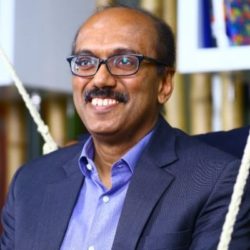
Virender Aggarwal is the CEO of Ramco. He joined the company in 2012 from HCL and has led the growth of the ERP company, helping it to expand across Asia and into Europe and the US. He has a driving focus on making Ramco innovative in a crowded market place. Ramco has three main products foci, its traditional ERP solution, Ramco HCM including payroll and its MRO solution for aerospace and defence.
ET: Who is your inspiration and why?
V Aggarwal: Steve Jobs. I think that innovation is the key to creating value. I’m personally very much against cold calling or pushing the product. I believe that people should queue up to buy your product.
ET: How do you describe your leadership style?
V Aggarwal: My style is very informal, somewhat hierarchy less. I believe a leader sets an example, and I want to lead by example. No props … nobody carries my bag in India, which is very common. I carry my own bags. I fly the equivalent of Ryan Air, cheap economy because the company was in trouble. I’m also very much hands on. If required, I open up the code to have a look at it.
I believe that leaders command respect from what they know, what they do, ideas they generate and the willingness to listen to people no matter how junior they might be. I value skill and talent not designations or seniority. People can see me hanging around with the fresh grads in the cafeteria sometimes because I find they have interesting ideas. I normally leave people to their doings. If they need my attention, they’re not doing a good job. Normally I focus a lot on innovation. I’m not the person who likes to do operations or count numbers or look at anybody’s travel bills because I believe that I implicitly trust people unless they prove otherwise.
ET: What are your personal challenges for the next 12 months?
V Aggarwal: The biggest struggle that I have is to find the right people and attract the right skills. To culturally mould the people that we have to accept the bright young people coming into the company. To be able to make more and more people buy into the changes that we’re bringing about. They need to understand that the underpinning cornerstone of the future lies in innovation. That means that change is going to be continuous and unending.
ET: What was your darkest business day and how did you overcome it?
V Aggarwal: A previous company was identified in the biggest corporate scandal. I was among the top five executives put on the spot on TV. People were accusing all of us of being part of that fraud. The lawyers were calling to help. People were asking us to take anticipatory bail and stuff like that. Despite working so hard, to be framed like somebody involved in that was really a low moment. Eventually we all came out of it. Four successful careers without an end to anybody’s reputation and without anybody’s involvement in the next level other than the owners of the company.
ET: What was your proudest moment?
V Aggarwal: Personally it was when my daughter got admission into Berkeley. I always wanted to study at an Ivy League or good brand name university. Unfortunately, at the time I didn’t have the kind of money to go and study in the US. Another proud moment was when recently we signed with one of the top three aerospace companies.
ET: Could you share a tip for new CEOs?
V Aggarwal: You have to continuously scan the horizon. You have to be able to read the tea leaves, to get your organisation ready for what is coming before it comes. We are getting ready for blockchain now, so that we can introduce it into the product. Change is going to kill the company more than anything else, so you have to be ahead of it. That means that you have to be reading two to three hours a day.
Do not be a transitional CEO. A CEO has to lead, to show the vision, be hands on enough to get it translated into execution because there is nothing to vision without execution. I spend a couple of hours every day to study what’s going on in the market. The people up with the latest trends and what is the latest in the Silicon Valley. I think that’s the key for the CEO, to be very much plugged in and not have a corner office to which only the secretary would allow access. If you see my office, anybody’s free to enter.
ET: What was your latest business book you read? Or your favourite book or podcast?
V Aggarwal: I haven’t read a book for a very long period of time. The last one I read was probably a few years back called, “Maverick“. I have a low attention span and I do not have enough patience to read a complete book. I read one that was by the Starbucks founder. I’m forgetting the name. I was kind of intrigued. How do you sell a $5 coffee that should cost you 50 cents or $1. (The book is Pour Your Heart Into It: How Starbucks built a company one cup at a time by Howard Schultz).
ET: What keeps you up at night?
V Aggarwal: The only thing that worries me at night is whether we are transforming ourselves rapidly enough because whatever I think, it is very difficult to have it translate into action or product. I’m thinking too far ahead and most people think I have lost my mind or something. When I started talking about bots, most people thought: “Here he goes again, another crazy idea.”. It has started to become mainstream. Now I’m on blockchain. People think that I’ve gone crazy. My main thing is how to get the organisation to move as fast as I want to move.
I also have lots of thoughts on zero UI. There should be no screens. They are fairly atypical ideas, revolutionary ideas but it’s difficult to have anybody to appreciate it within my own company, let alone outside.
ET: What is the Ramco vision?
V Aggarwal: We want to build something that people want to queue up to buy. Just beat the competition to death, not by marketing heft or marketing dollars or brand building or something, just by sheer novelty and innovation. Almost like break into the market like Fitbit and catch the imagination of people.
ET: What’s the key business challenge for the next 12 months?
V Aggarwal: We have to make our product more reliable and easier to implement. The problem is when you get the work done in India, the psychological thinking is that it’s okay if it breaks down. You are quite used to repairing or making amends and so on. The challenge is to make a very robust, reliable product which doesn’t break down, doesn’t require too many patches and so on. Also not to take too much implementation time.
ET: What’s the worst and best decisions you’ve made as a CEO?
V Aggarwal: The worst decision in hindsight was I took too long to let some people go. I was not decisive enough to close down certain product lines faster.
Best decision was to keep embracing new technology and keep pushing the agenda of easy to use systems. Wherever I found people resisting change, to replace them. Now we have a few more people who believe in what I’m talking, rather than either silently or openly resisting.
ET: What are the advantages of being an Indian start-up in Singapore?
V Aggarwal: There is a perceived notion that the manpower is a lower cost, which it is not. Not the kind of people you need. Not the exceptionally bright people. I don’t think there’s a particular advantage to being an Indian start-up. Having said that, there is the abundance of talent and the fairly robust ecosystem of new start-ups coming up in the country. Lots of brain power is available easily. I’ve lived too long outside India to be able perceive the advantages. I have a view that it’s a lot easier to get the best talent in the world to work for me in Singapore than work in India. To convince the brightest Chinese, Vietnamese, French, English or Russian to work with us in Singapore is a lot easier than to convince anybody to work with us in India. I don’t think I can persuade a Japanese to work with us in India for love or money.
So that is the challenge to attract the kind of extra bright, crazy people. We do the craziest pieces of work in Singapore. A little bit less crazy work in India, which we can do with the right kind of people. We are not a brand which will attract the people in India. Our Indian engineers would love to join Facebook or Google or something like that. Ramco I don’t think features anywhere on their list. They cannot impress their girlfriend or boyfriend if they were to join Ramco in India, but definitely we are a company of choice in Singapore.
ET: What does the competitive threat landscape look like?
V Aggarwal: I don’t see too many people looking forward. I respect IFS from Sweden a lot. They’re doing some good work. They seem to be technologically sound. They also have started doing acquisitions but I don’t think they’ve done as many acquisitions. The other big boys all seem to be acquiring companies. I don’t think that is a strategy that works easily because if you buy a single product of theirs you may be buying three different clouds, three different user interfaces, and so on. The biggest dangers come from specialist vendors.
In the HR field the competition can be coming from the likes of Ultimate Software in the US or Namely. I would say Workday can be a threat. They are expanding into financials now and I am sure they will follow the PeopleSoft blueprint. I think the only single platform, single code base, built on modern design, HTML5, responsive solution is Workday. For full range ERP, I don’t think there is a single product which is not 25-30 years old.
ET: You’ve mentioned speed of deployment. What are customers looking for? Are they looking for speed, flexibility or return on investment in value? Is there a balance between that?
V Aggarwal: My feeling is people used to take pride in the fact that their requirements are unique. Increasingly this uniqueness notion will keep going away from their mind. They will more and more conform to whatever’s available in the market. In that context, customers would like something which they can more or less plug and play.
The ease of use, plug and play and quickness of being up and running will be more important than anything going forward. That’s what will matter. Flexibility, yes, to be able configure to as per your needs, but not necessarily your own piece of code. If you want your logo on your payslips or invoices, or you want GST in one country versus VAT in another country, the system should be able to do all that without breaking a sweat. I think customization, with an army of consultants becoming is passé. I don’t think anybody in the right frame of mind is going to announce a $100 million implementation project.
ET: How do you see the company changing in the next two years and how do you see yourself helping to create that change?
V Aggarwal: My feeling is we would have to cater to the digital transformation agenda of the customers. That means that products should be able to help them become a lot more digital, with better robotic process automation in the processes. Take the routine away and build more and more cognitive capability. For example we will suggest to them you should order this much quantity at this price. The system will come out with suggestions. You can pass the invoices without having a second look. This invoice needs attention and this invoice needs to be referred back to the supplier.
The world we want to move toward is what we call frictionless computing.
Self-running finances and so on. When we say frictionless we mean that when you walk into the office your attendance gets automatically marked without you knowing because we have done facial recognition to know that you are in the office. That’s called frictionless. If you are getting in 3rd party suppliers based on their time sheets, you can also suggest this invoice to them. If they accept it you can send the money back to them. That’s what I mean by frictionless. Wherever there is no exception, processing should be automatic without requiring a single minute of any human being. Whenever the processing has exceptions and is not programmed into the system, only that should require intervention. Essentially cognitive, embedding robotic process automation and assisting in the digital transformation of the company.
ET: How do you approach the challenge of rapid growth while maintain culture?
V Aggarwal: We don’t want to increase the headcount too much. We believe we must keep automating ourselves and that’s what we preach to our clients. Culture can go out of place if you induct too many employees too rapidly. Second, to have a lot more interaction built in and we are using many social tools.
We want to give freedom to the employees who think the bosses don’t fit in. We continuously measure the happiness index. For example, if a particular manager joins a department and the happiness drops, we realise that the person, the manager, doesn’t fit into the scheme of things. We believe rapid change and rapid hiring of people can disturb the culture. Having said that, it’s a tough balancing act. There’s no silver bullet which can answer: “How to make good things happen”. You just have to keep the disruption to the culture minimal.
ET: How do you prioritise your day and what and on how much time you spend on different areas? You mention you spend two hours kind of learning. What else do you spend your time doing?
V Aggarwal: I spend a lot of time on product design, product strategy and prioritising new features. A lot of time listening to the market inputs, to what the market is telling us. Meetings, maybe 25% of the time, meeting customers and partners. About 50% of the time involved in detailed product strategy, product design, including screen designs. Yesterday, I even opened up the code to have a look to see why the system is running slow. A lot of time, outside office hours, I’m reading. I spend about 10-20 minutes a night on catching up on what’s happening globally.
ET: Is technology changing the world for the betterment of society?
V Aggarwal: Artificial Intelligence and deep learning are going to be existential to mankind. It puts them in danger of being slave to a somebody who either controls the super intelligent computers or it will take control. I would put a limit to how AI is embeds into society.
Gene editing means you can have designer children now. How it manifests in many ways, we don’t know. Like in genetically modified food. While I am a technologist, we may be going in a direction which may be irreparable for mankind. If I were to personally change the world I would have to think of ways to put limits on certain areas because of the consequences. People used pesticides earlier without realising how it will affect human beings. More and more we are just using technology without realising the consequences. Like global warming for all the nice things we have gotten used to in life. Many parts of the world may not be liveable anymore. My feeling is some of those areas that we are getting into can be troublesome. If I were to change the world I would think of ways of creating legislation to put a level to which these things can go on.
ET: Simon Sinek talks about the “Start with Why” in his book. Why does Ramco exist in that sense and how is that improving society?
V Aggarwal: Simon Sinek makes very interesting reading. The sole purpose of our existence is to bring to the business world the benefits that have come to the consumer world through technology. In today’s world, the consumer world allows a better quality of interaction with the technology than the business world. Our objective is to bring some semblance of betterment of life to the time you spend in office.
ET: What’s the one question you’d like to ask another CEO to answer?
V Aggarwal: How do you keep the enthusiasm going perpetually? You can motivate the team for a big game, but how do you keep them motivated for playing the last game in the league?
ET: Can you answer that question yourself?
V Aggarwal: I ask the question all the time. A lot of the time I see people getting tired, enthusiasm flagging. Some people ask me what are the biggest challenges you have. I said whatever disappointment or the burden I carry, don’t show them on my face. I have to look cheerful to pull people along. Every person goes through their private moments of disappointment, moments of agony, moment of hopelessness. For me, to not show it on the face is the single most important thing. To keep the team continuously excited and have a development spirit is definitely something that I think is a challenge. I try my best to do whatever I can. It’s definitely not an easy task.
ET: Thank you




























Candid responses from va-san